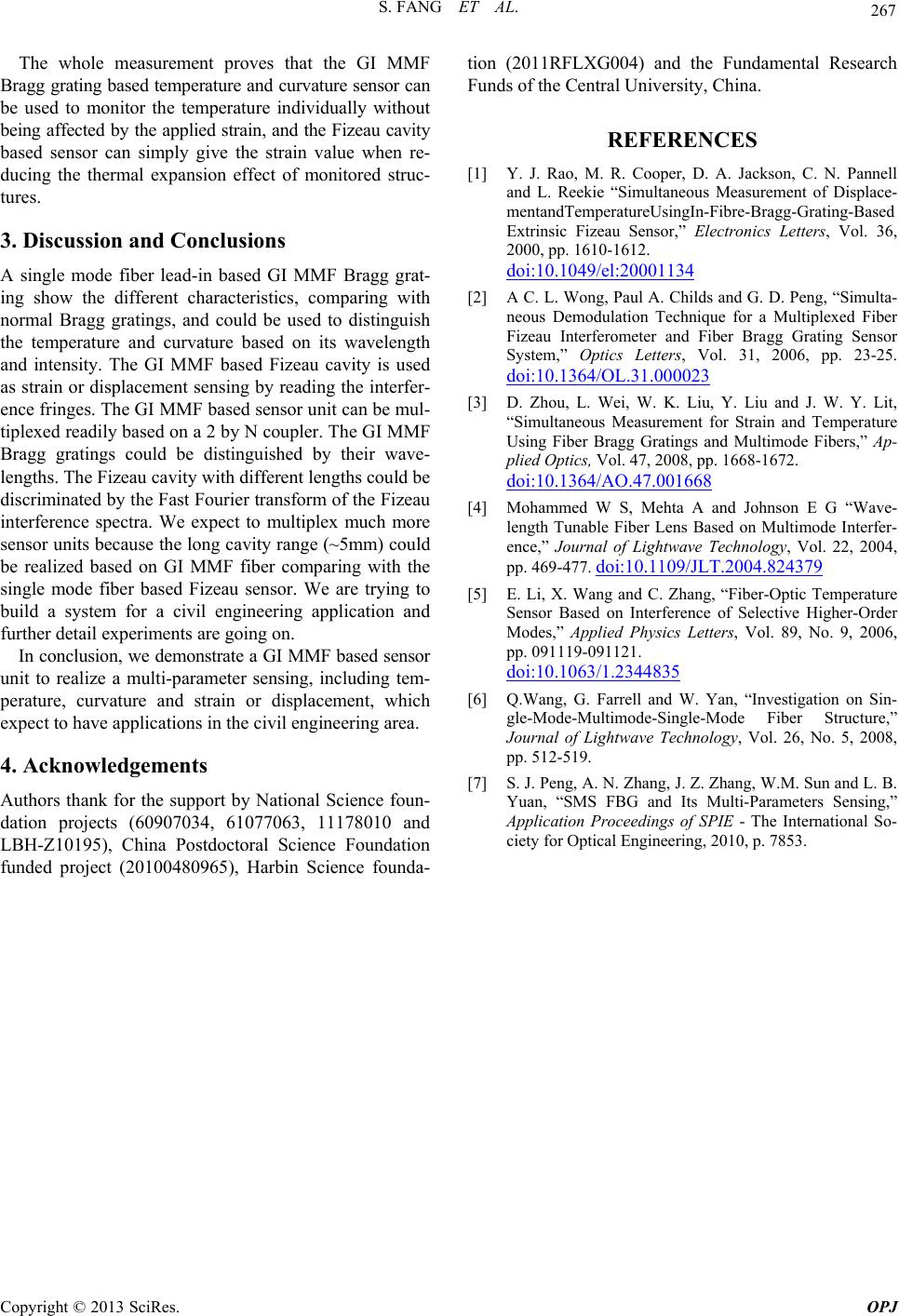
S. FANG ET AL. 267
The whole measurement proves that the GI MMF
Bragg grating based temperature and curvature sensor can
be used to monitor the temperature individually without
being affected by the applied strain, and the Fizeau cavity
based sensor can simply give the strain value when re-
ducing the thermal expansion effect of monitored struc-
tures.
3. Discussion and Conclusions
A single mode fiber lead-in based GI MMF Bragg grat-
ing show the different characteristics, comparing with
normal Bragg gratings, and could be used to distinguish
the temperature and curvature based on its wavelength
and intensity. The GI MMF based Fizeau cavity is used
as strain or displacement sensing by reading the interfer-
ence fringes. The GI MMF based sensor unit can be mul-
tiplexed readily based on a 2 by N coupler. The GI MMF
Bragg gratings could be distinguished by their wave-
lengths. The Fizeau cavity with different lengths could be
discriminated by the Fast Fourier transform of the Fizeau
interference spectra. We expect to multiplex much more
sensor units because the long cavity range (~5mm) could
be realized based on GI MMF fiber comparing with the
single mode fiber based Fizeau sensor. We are trying to
build a system for a civil engineering application and
further detail experiments are going on.
In conclusion, we demonstrate a GI MMF based sensor
unit to realize a multi-parameter sensing, including tem-
perature, curvature and strain or displacement, which
expect to have applications in the civil engineering area.
4. Acknowledgements
Authors thank for the support by National Science foun-
dation projects (60907034, 61077063, 11178010 and
LBH-Z10195), China Postdoctoral Science Foundation
funded project (20100480965), Harbin Science founda-
tion (2011RFLXG004) and the Fundamental Research
Funds of the Central University, China.
REFERENCES
[1] Y. J. Rao, M. R. Cooper, D. A. Jackson, C. N. Pannell
and L. Reekie “Simultaneous Measurement of Displace-
mentandTemperatureUsingIn-Fibre-Bragg-Grating-Based
Extrinsic Fizeau Sensor,” Electronics Letters, Vol. 36,
2000, pp. 1610-1612.
doi:10.1049 /el:20001134
[2] A C. L. Wong, Paul A. Childs and G. D. Peng, “Simulta-
neous Demodulation Technique for a Multiplexed Fiber
Fizeau Interferometer and Fiber Bragg Grating Sensor
System,” Optics Letters, Vol. 31, 2006, pp. 23-25.
doi:10.1364 /OL.31.000023
[3] D. Zhou, L. Wei, W. K. Liu, Y. Liu and J. W. Y. Lit,
“Simultaneous Measurement for Strain and Temperature
Using Fiber Bragg Gratings and Multimode Fibers,” Ap-
plied Optics, Vol. 47, 2008, pp. 1668-1672.
doi:10.1364 /AO.47.001668
[4] Mohammed W S, Mehta A and Johnson E G “Wave-
length Tunable Fiber Lens Based on Multimode Interfer-
ence,” Journal of Lightwave Technology, Vol. 22, 2004,
pp. 469-477. doi:10.1109/JLT.2004 .824379
[5] E. Li, X. Wang and C. Zhang, “Fiber-Optic Temperature
Sensor Based on Interference of Selective Higher-Order
Modes,” Applied Physics Letters, Vol. 89, No. 9, 2006,
pp. 091119-091121.
doi:10.1063 /1.2344835
[6] Q.Wang, G. Farrell and W. Yan, “Investigation on Sin-
gle-Mode-Multimode-Single-Mode Fiber Structure,”
Journal of Lightwave Technology, Vol. 26, No. 5, 2008,
pp. 512-519.
[7] S. J. Peng, A. N. Zhang, J. Z. Zhang, W.M. Sun and L. B.
Yuan, “SMS FBG and Its Multi-Parameters Sensing,”
Application Proceedings of SPIE - The International So-
ciety for Optical Engineering, 2010, p. 7853.
Copyright © 2013 SciRes. OPJ